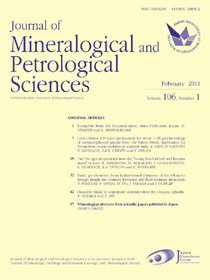All issues

Volume 99 (2004)
- Issue 6 Pages 363-
- Issue 5 Pages 257-
- Issue 4 Pages 137-
- Issue 3 Pages 83-
- Issue 2 Pages 59-
- Issue 1 Pages 1-
Volume 99, Issue 3
June
Displaying 1-3 of 3 articles from this issue
- |<
- <
- 1
- >
- >|
REVIEW
-
H.M. RAJESH2004 Volume 99 Issue 3 Pages 83-103
Published: 2004
Released on J-STAGE: November 16, 2004
JOURNAL FREE ACCESSRemote sensing, as a direct adjunct to field, lithologic and structural mapping, and more recently, GIS have played an important role in the study of mineralized areas. A review on the application of remote sensing in mineral resource mapping is attempted here. It involves understanding the application of remote sensing in lithologic, structural and alteration mapping. Remote sensing becomes an important tool for locating mineral deposits, in its own right, when the primary and secondary processes of mineralization result in the formation of spectral anomalies. Reconnaissance lithologic mapping is usually the first step of mineral resource mapping. This is complimented with structural mapping, as mineral deposits usually occur along or adjacent to geologic structures, and alteration mapping, as mineral deposits are commonly associated with hydrothermal alteration of the surrounding rocks. In addition to these, understanding the use of hyperspectral remote sensing is crucial as hyperspectral data can help identify and thematically map regions of exploration interest by using the distinct absorption features of most minerals. Finally coming to the exploration stage, GIS forms the perfect tool in integrating and analyzing various georeferenced geoscience data in selecting the best sites of mineral deposits or rather good candidates for further exploration.View full abstractDownload PDF (1330K)
ORIGINAL ARTICLES
-
Satoshi SAITO, Makoto ARIMA, Takashi NAKAJIMA, Jun-Ichi KIMURA2004 Volume 99 Issue 3 Pages 104-117
Published: 2004
Released on J-STAGE: November 16, 2004
JOURNAL FREE ACCESSThe Ashigawa and the Tonogi intrusions comprise the southern part of the Miocene Kofu Granitic Complex (KGC), which is the largest pluton exposed in the Izu collision zone. The Ashigawa intrusion mainly consists of tonalite and subordinate amounts of trondhjemite, and the Tonogi intrusion is predominantly composed of tonalite. The rocks in both intrusions are classified as M-type granite. These are characterized by relatively low K2O (<1.9 wt.%) and Rb (<48 ppm) and LREE enriched chondrite normalized REE patterns with a marked negative Eu anomaly. Compared to the Tanzawa tonalites distributed in the south of the KGC, the Ashigawa and Tonogi granitic rocks have higher LILE, REE and Sr-isotope compositions at a given whole rock SiO2 content. Although the Ashigawa intrusion has distinctly different petrographical and geochemical characteristics from the Tonogi intrusion, both intrusions exhibit nearly identical Sr-isotopic composition (0.7037-0.7043 at 13Ma) and well-defined variation in whole rock compositions, suggesting that they are comagmatic. The crystal fractionation modeling involving removals of amphibole, plagioclase and magnetite from a tonalitic parental magma composition well represents the major and trace element variation of the Ashigawa and Tonogi granitic rocks. The Rayleigh fractionation modeling for whole rock REE abundance is also in a good agreement with the observed whole rock data. Mass balance modeling suggests that the proposed tonalitic parental magma can be derived by ∼40 % melting of hydrous basalt compositionally similar to the basalt occurring in the rift basin of northern Izu-Bonin arc. Anatexis of hydrous basaltic lower crust of the northern Izu-Bonin arc is a likely process for the formation of Ashigawa-Tonogi parental magma.View full abstractDownload PDF (651K) -
Takahiro KURIBAYASHI, Hiroyuki KAGI, Masahiko TANAKA, Mizuhiko AKIZUKI ...2004 Volume 99 Issue 3 Pages 118-129
Published: 2004
Released on J-STAGE: November 16, 2004
JOURNAL FREE ACCESSHigh-pressure single crystal X-ray diffraction studies of a natural chondrodite, Mg4.76Fe0.22Ti0.02Si1.99O8(OH1.26F0.74), and a synthetic OH-chondrodite, Mg4.98Si2.01H2.00O10, were performed using a diamond anvil cell (DAC) up to 7.3 and 5.9 GPa, respectively and at room temperature. FT-IR spectra of the natural chondrodite under high-pressure conditions up to 9.9 GPa was also observed using a DAC. The axial linear compressibilities of these samples are calculated as βa = 1.69(4) × 10−3, βb = 2.98(4) × 10−3 and βc = 2.74(5) × 10−3 (GPa−1) for the natural chondrodite and βa = 2.11(18) × 10−3, βb = 2.83(18) × 10−3 and βc = 3.04(38) × 10−3 (GPa−1) for the synthetic OH-chondrodite. The isothermal bulk moduli of these samples were calculated as KT = 124.1(4) GPa for the natural chondrodite and KT = 117(2) GPa for the OH-chondrodite, by using the Birch-Murnaghan equation of state assuming K' = 4. The bulk moduli of total void space in each sample, assuming K' = 4, were calculated to be K⌊ = 116(2) GPa for the natural chondrodite and K⌊ = 113(4) GPa for the OH-chondrodite. The plots of bulk modulus versus the summation of the filling-factor of polyhedral sites show a good correlation between the humite minerals. This relationship can be explained by the replacement of 4O2− + Si4+ ⇔ 4(F, OH)− + ⌊ generated in the humite homologous series. In the FT-IR spectra of the natural chondrodite, four OH-stretching vibrational peaks were observed at 3688, 3566, 3558 and 3383 cm−1 under ambient conditions. The pressure dependences of the frequency of these peaks up to 9.9 GPa are 2.8(3), 3.9(3), 4.0(3) and −2.1(2) (cm−1GPa−1), respectively. With increasing pressure up to 9.9 GPa, the 3383 cm−1 peak shifts to lower-frequency positions, whereas the other peaks shift to higher-frequency positions. The shortening of the O5···O5 distance, which is not the shared edge between M3 octahedra, related to hydrogen bonding with increasing pressure causes the negative pressure-dependence of the 3383 cm−1 peak. The positive pressure-dependence of the remaining IR-peaks is due to the compression of the O5-H bond, and not related to hydrogen bonding with increasing pressure.View full abstractDownload PDF (774K)
- |<
- <
- 1
- >
- >|